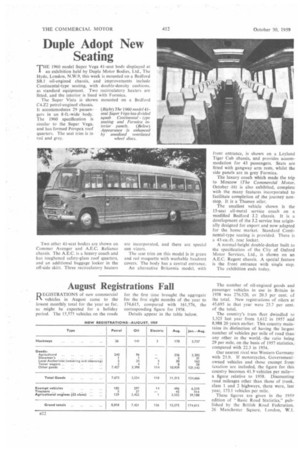Duple Adopt New Seating
Page 56

If you've noticed an error in this article please click here to report it so we can fix it.
THE 1960 model Super Vega 41-seat body displayed at an exhibition held by Duple Motor Bodies, Ltd., The Hyde, London, N.W.9, this week is mounted on a Bedford SB.1 oil-engined chassis, and improvements include Continental-type seating, with double-density cushions, as standard equipment. Two recirculatory heaters arc fitted, and the interior, is lined with Formica.
Two other 41-seat bodies are shown on Commer Avenger and A.E.C. Reliance chassis. The A.E.C. is a luxury coach and has toughened safety-glass roof quarters, and an additional baggage locker in the off-side skirt. Three recirculatory heaters are incorporated, and there arc special sun vizors.
The seat trim on this model is in green and red moquette with washable headrest covers. The body has a central entrance.
An alternative Britannia model, with front entrance, is shown on a Leyland Tiger Cub chassis, and provides accommodation for 43 passengers. Seats are fitted with gangway arm rests, whilst the side panels are in grey Formica.
The luxury coach which made the trip to Moscow (The Commercial Motor, October .16) is also exhibited, complete with the many features incorporated to facilitate completion of the journey nonstop. It is a Thames oiler.
The smallest vehicle shown is the 15-seat all-metal service coach on a modified Bedford 1.2 chassis. It is a development of the J.2 service bus originally designed for export and now adapted for the home market. Standard Continental-type seating is provided. There is a 43-cu.-ft. rear locker.
A normal-height double-decker built to the specification of the City of Oxford Motor Services, Ltd., is shown on an A.E.C. Regent chassis. A special feature is the front entrance with single step.
The exhibition ends today.
The number of oil-engined goods and passenger vehicles in use in Britain in 1958 was 276,520. or 20.3 per cent. a the total. New registrations of oilers at 45,695 in that year were 25.7 per cent. of the total.
The country's tram fleet dwindled to 1,325 last year from 1,612 in 1957 and 8,988 20 years earlier. This country maintains its distinction of having the largest number of vehicles per mile of road than any other in the world.-the ratio being 29 per mile, on the basis of 1957 statistics,. compared with 22.3 in 1954.
Our nearest rival was Western Germany with 21.9. If motorcycles, Governmentowned vehicles and those exempt from taxation are included, the figure for this country becomes 41.3 vehicles per mile— a figure relative to 1958. Discounting road mileages other than those of trunk, class 1 and 2 highways, there were, last year, 173.1 vehicles per mile.
These figures are given in the 1959 edition of "Basic Road Statistics," published by the British Road Federation, 26 Manchester Square, London, W.1.




















































































































